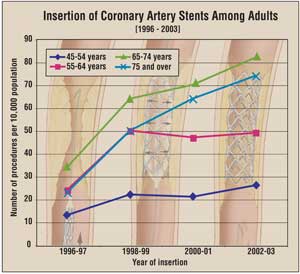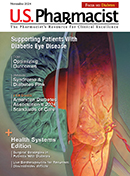US Pharm. 2007;32(3):12.
Blockage of the coronary arteries is
a major cause of heart disease and heart attacks. Technological advances in
the treatment of blocked arteries include the introduction of coronary artery
bypass graft (CABG) surgery, or cardiac revascularization, in the late 1960s
and percutaneous transluminal coronary angioplasty (PTCA), or balloon
angioplasty, in the late 1970s (now often called percutaneous coronary
intervention). Both procedures are preceded by cardiac catheterization, which
measures the location and extent of coronary artery blockage. The use of CABG,
PCTA, or an alternative procedure depends on various factors, such as location
of blockage, number of blockages, and extent of blockage.
In 1996, the FDA established a Product Code for the coronary artery stent to
ensure its safety and effectiveness. Stenting is performed in combination with
the PCTA procedure. Since the mid-1990s, angioplasty has been used
increasingly with the insertion of stents because of the lower renarrowing
rates of opened arteries (restenosis). According to the American Heart
Association, 70% to 90% of PCTA procedures involve the placement of a stent.

From 2002 to 2003, there were more
than 500,000 hospital discharges involving at least one coronary stent
insertion procedure among adults 45 and older. Between 1996 and 1997 and 2002
to 2003, the rate of coronary stent insertion procedures for adults 45 and
older more than doubled from 22 to 49 per 10,000 population. Among adults 75
and older, the rate of hospitalizations that included this procedure more than
tripled from 23 per 10,000 population in 1996 to 1997 to 73 per 10,000
population in 2002 to 2003. For persons ages 45 to 64, the rate of stent
procedures per population stabilized after 1999, but the rate continued to
rise in persons 65 and older, in part because PTCA and stenting are
considerably less invasive than CABG and can be performed on older persons who
are likely to have other medical conditions that preclude more extensive
open-heart CABG surgery. In contrast to rising rates of stent insertions,
rates for CABG procedures declined among adults ages 45 to 64 and remained
stable for adults 75 and older.
Medical innovations developed during the last 30 years, such as CABG, PCTA,
and the intracoronary stent, have contributed to improved survival for heart
attack patients. It is estimated that around 70% of survival improvement in
heart attack mortality is a result of these technological changes.
Furthermore, new drug-eluting stents show promise of reducing restenosis and
subsequent heart attacks.
To comment on this article, contact editor@uspharmacist.com.





